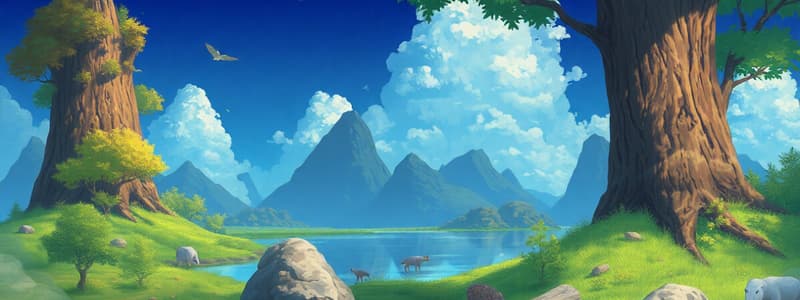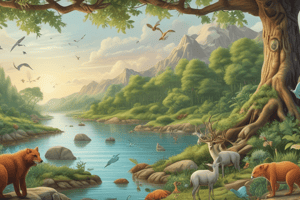Podcast
Questions and Answers
What primarily defines a biome?
What primarily defines a biome?
Which of the following is NOT considered a resource that organisms compete for in an ecosystem?
Which of the following is NOT considered a resource that organisms compete for in an ecosystem?
What percentage of Earth's surface do freshwater ecosystems cover?
What percentage of Earth's surface do freshwater ecosystems cover?
Which ecosystem type is known for its biodiversity, including coral reefs?
Which ecosystem type is known for its biodiversity, including coral reefs?
Signup and view all the answers
What do phytoplankton contribute to the ocean's ecosystem?
What do phytoplankton contribute to the ocean's ecosystem?
Signup and view all the answers
Which of the following statements about deep ocean bottom ecosystems is correct?
Which of the following statements about deep ocean bottom ecosystems is correct?
Signup and view all the answers
How are terrestrial ecosystems classified?
How are terrestrial ecosystems classified?
Signup and view all the answers
Which of the following is an example of a terrestrial biome?
Which of the following is an example of a terrestrial biome?
Signup and view all the answers
What role do abiotic factors play in community dynamics?
What role do abiotic factors play in community dynamics?
Signup and view all the answers
Which ecosystem is most common on Earth?
Which ecosystem is most common on Earth?
Signup and view all the answers
What is the primary role of producers in a food chain?
What is the primary role of producers in a food chain?
Signup and view all the answers
Why is the food chain considered a simplistic model of ecosystem structure?
Why is the food chain considered a simplistic model of ecosystem structure?
Signup and view all the answers
What does biomagnification refer to?
What does biomagnification refer to?
Signup and view all the answers
In a typical food chain, which of the following is considered an apex consumer?
In a typical food chain, which of the following is considered an apex consumer?
Signup and view all the answers
Which level of consumers primarily eat producers?
Which level of consumers primarily eat producers?
Signup and view all the answers
What is the primary limitation of food chains compared to food webs?
What is the primary limitation of food chains compared to food webs?
Signup and view all the answers
Which organism type can be classified as an autotroph?
Which organism type can be classified as an autotroph?
Signup and view all the answers
In terms of energy transfer, what percentage typically passes from one trophic level to the next?
In terms of energy transfer, what percentage typically passes from one trophic level to the next?
Signup and view all the answers
What term describes organisms that consume other organisms to obtain their energy?
What term describes organisms that consume other organisms to obtain their energy?
Signup and view all the answers
Which of the following accurately describes a tertiary consumer?
Which of the following accurately describes a tertiary consumer?
Signup and view all the answers
What primary effect does DDT accumulation have on bird populations?
What primary effect does DDT accumulation have on bird populations?
Signup and view all the answers
Which trophic level is most affected by biomagnification of substances like DDT?
Which trophic level is most affected by biomagnification of substances like DDT?
Signup and view all the answers
What was the primary reason for the ban on DDT in the 1970s in the United States?
What was the primary reason for the ban on DDT in the 1970s in the United States?
Signup and view all the answers
What is an example of a substance that also biomagnifies similar to DDT?
What is an example of a substance that also biomagnifies similar to DDT?
Signup and view all the answers
Which fish species have been advised against consumption due to high mercury content?
Which fish species have been advised against consumption due to high mercury content?
Signup and view all the answers
How do predatory fish demonstrate biomagnification in aquatic ecosystems?
How do predatory fish demonstrate biomagnification in aquatic ecosystems?
Signup and view all the answers
What is the recommendation for pregnant women regarding fish consumption?
What is the recommendation for pregnant women regarding fish consumption?
Signup and view all the answers
What was the context of the study performed by NOAA in Saginaw Bay?
What was the context of the study performed by NOAA in Saginaw Bay?
Signup and view all the answers
Which heavy metals have raised concerns due to biomagnification in seafood?
Which heavy metals have raised concerns due to biomagnification in seafood?
Signup and view all the answers
Why is biomagnification significant for understanding ecosystem dynamics?
Why is biomagnification significant for understanding ecosystem dynamics?
Signup and view all the answers
Study Notes
Ecosystem Ecology
- Life in an ecosystem involves competition for limited resources like food, water, sunlight, space, and minerals.
- Competition occurs within and between species.
- Environmental factors influence community dynamics like climate, elevation, and geology.
- Three broad categories of ecosystems: freshwater, marine, and terrestrial.
- Freshwater ecosystems are the least common, covering only 1.8% of Earth's surface.
- Marine ecosystems are the most common, encompassing 75% of Earth's surface, with three types: shallow ocean, deep ocean water, and deep ocean bottom.
- Terrestrial ecosystems are grouped into biomes determined by dominant plant types and similar climatic conditions.
Food Chains and Food Webs
- A food chain is a linear sequence of organisms through which nutrients and energy pass.
- Trophic levels define the position of organisms in the food chain: producers, primary consumers, and higher-level consumers.
- Producers are photosynthetic organisms at the base of the food chain.
- Primary consumers are herbivores consuming producers.
- Secondary consumers are carnivores eating primary consumers.
- Tertiary consumers are carnivores eating other carnivores.
- Apex predators are at the top of the food chain, not being eaten by any other consumers.
- Energy is lost at each trophic level, typically around 10%, limiting the number of trophic levels.
- Food webs are more accurate representations of ecosystems, accounting for multiple interactions and trophic connections across levels.
Energy Acquisition in Food Webs
- Autotrophs produce their own food through photosynthesis, like plants, algae, and certain bacteria.
- Heterotrophs obtain energy by consuming other organisms, including animals and humans.
- Heterotrophs depend on autotrophs for their energy source.
Biomagnification
- Biomagnification, also known as bioaccumulation, is the increasing concentration of toxic substances in organisms at higher trophic levels.
- Fat-soluble substances, like DDT, PCBs, and heavy metals, accumulate in organisms' fat reserves.
- DDT was banned in the US due to its negative impact on apex predators like bald eagles.
- Mercury and cadmium in seafood pose health risks, especially for pregnant women and children.
Photosynthesis
- Photosynthesis is the process used by autotrophs to convert sunlight and carbon dioxide into chemical energy in the form of carbohydrates.
- This process requires sunlight and is essential for life on Earth.
Studying That Suits You
Use AI to generate personalized quizzes and flashcards to suit your learning preferences.
Description
Test your knowledge on ecosystem ecology, including competition for resources, community dynamics, and the different types of ecosystems. Dive into food chains and webs to understand trophic levels and the roles of producers and consumers in energy transfer. This quiz covers fundamental concepts in environmental science and ecological relationships.




